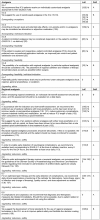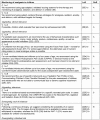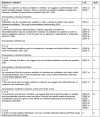Evidence and consensus based guideline for the management of delirium, analgesia, and sedation in intensive care medicine. Revision 2015 (DAS-Guideline 2015) - short version
- PMID: 26609286
- PMCID: PMC4645746
- DOI: 10.3205/000223
Evidence and consensus based guideline for the management of delirium, analgesia, and sedation in intensive care medicine. Revision 2015 (DAS-Guideline 2015) - short version
Abstract
In 2010, under the guidance of the DGAI (German Society of Anaesthesiology and Intensive Care Medicine) and DIVI (German Interdisciplinary Association for Intensive Care and Emergency Medicine), twelve German medical societies published the "Evidence- and Consensus-based Guidelines on the Management of Analgesia, Sedation and Delirium in Intensive Care". Since then, several new studies and publications have considerably increased the body of evidence, including the new recommendations from the American College of Critical Care Medicine (ACCM) in conjunction with Society of Critical Care Medicine (SCCM) and American Society of Health-System Pharmacists (ASHP) from 2013. For this update, a major restructuring and extension of the guidelines were needed in order to cover new aspects of treatment, such as sleep and anxiety management. The literature was systematically searched and evaluated using the criteria of the Oxford Center of Evidence Based Medicine. The body of evidence used to formulate these recommendations was reviewed and approved by representatives of 17 national societies. Three grades of recommendation were used as follows: Grade "A" (strong recommendation), Grade "B" (recommendation) and Grade "0" (open recommendation). The result is a comprehensive, interdisciplinary, evidence and consensus-based set of level 3 guidelines. This publication was designed for all ICU professionals, and takes into account all critically ill patient populations. It represents a guide to symptom-oriented prevention, diagnosis, and treatment of delirium, anxiety, stress, and protocol-based analgesia, sedation, and sleep-management in intensive care medicine.
Die vorherige Version der S3-Leitlinie „Analgesie, Sedierung und Delirmanagement in der Intensivmedizin“ wurde 2010 unter der Federführung der Deutschen Gesellschaft für Anästhesiologie und Intensivmedizin (DGAI) und der Deutschen Interdisziplinären Vereinigung für Intensiv- und Notfallmedizin (DIVI) publiziert. Neue Evidenz aus Studien ebenso wie neue Leitlinien, u.a. die 2013 erschienene Leitlinie der U.S.-amerikanischen Society of Critical Care Medicine (SCCM), des American College of Critical Care Medicine (ACCM) und der American Society of Health-System Pharmacists (ASHP), gaben nicht nur Anlass zu einem Update der deutschen Empfehlungen von 2010. Für die Fortschreibung der S3-Leitlinie wurden eine Neuformulierung von klinisch relevanten Schlüsselfragen und die signifikante Erweiterung der Leitlinie um neue Facetten der Behandlung, wie zum Beispiel das Schlafmanagement, notwendig. Dazu wurde die systematisch gesuchte Literatur nach Kriterien des Oxford Centre of Evidence Based Medicine bewertet. Der enorme Evidenzkörper bildete die Grundlage für die Empfehlungen, die von Mandatsträgern aus 17 Fachgesellschaften konsentiert wurden. In den Empfehlungen wurden die Grade „A“ (starke Empfehlung), „B“ (Empfehlung) und „0“ (offene Empfehlung) gewählt. Als Ergebnis dieses Prozesses liegt nun die weltweit umfassendste, interdisziplinär erarbeitete evidenz- und konsensbasierte Stufe 3 Leitlinie vor. Die Leitlinie richtet sich an alle auf der Intensivstation tätigen Berufsgruppen, die Empfehlungen berücksichtigen alle intensivmedizinisch-behandelten Patientengruppen. Sie stellt einen Leitfaden zur symptomorientierten Prävention, Diagnostik und Therapie von Delir, Angst, Stress und der protokollbasierten Analgesie, Sedierung und dem Schlafmanagement in der Intensivmedizin für Erwachsene und Kinder dar.
Keywords: Germany; analgesia; anxiety; critical care; delirium; evidence; guideline; intensive care; monitoring; sedation; sleep; stress; treatment.
Figures






































References
-
- OCEBM Levels of Evidence Working Group. The Oxford 2011 Levels of Evidence. Oxford Centre for Evidence-Based Medicine; Available from: http://www.cebm.net/index.aspx?o=5653.
-
- The ADAPTE Collaboration. The ADAPTE Process: Toolkit for Guideline Adaptation. Version 2.0. 2009. Available from: http://www.g-i-n.net/document-store/working-groups-documents/adaptation/....
-
- Mehta S, Cook D, Devlin JW, Skrobik Y, Meade M, Fergusson D, Herridge M, Steinberg M, Granton J, Ferguson N, Tanios M, Dodek P, Fowler R, Burns K, Jacka M, Olafson K, Mallick R, Reynolds S, Keenan S, Burry L SLEAP Investigators; Canadian Critical Care Trials Group. Prevalence, risk factors, and outcomes of delirium in mechanically ventilated adults. Crit Care Med. 2015 Mar;43(3):557–566. doi: 10.1097/CCM.0000000000000727. Available from: http://dx.doi.org/10.1097/CCM.0000000000000727. - DOI - DOI - PubMed
-
- Ely EW, Shintani A, Truman B, Speroff T, Gordon SM, Harrell FE, Jr, Inouye SK, Bernard GR, Dittus RS. Delirium as a predictor of mortality in mechanically ventilated patients in the intensive care unit. JAMA. 2004 Apr;291(14):1753–1762. doi: 10.1001/jama.291.14.1753. Available from: http://dx.doi.org/10.1001/jama.291.14.1753. - DOI - DOI - PubMed
-
- Ouimet S, Kavanagh BP, Gottfried SB, Skrobik Y. Incidence, risk factors and consequences of ICU delirium. Intensive Care Med. 2007 Jan;33(1):66–73. doi: 10.1007/s00134-006-0399-8. Available from: http://dx.doi.org/10.1007/s00134-006-0399-8. - DOI - DOI - PubMed

